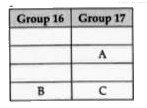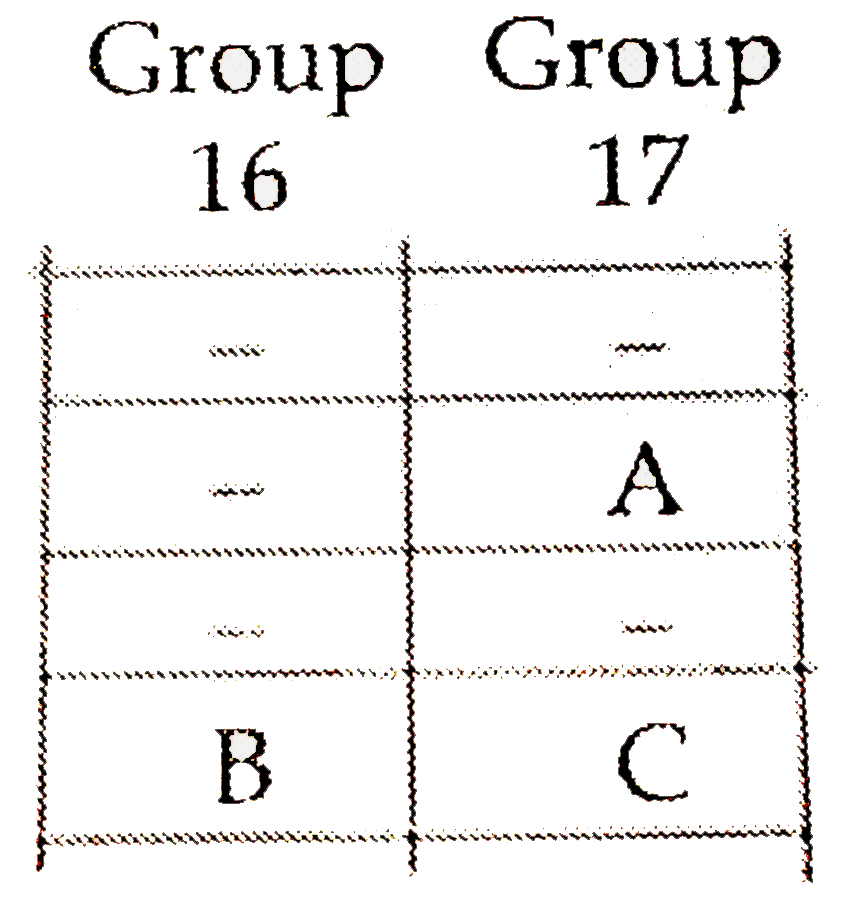The position of three elements A, B and C in the periodic Table is shown below:

(a) State whether A is a metal or non-metal
(b) State whether C is more reactive or less reactive than A
( c) Will C be larger or smaller in size than B?
(d) Which type of ion, cation or anion, will be formed by element C?Solution in Kannada
a] Since element A is in group 17, it has 17-10 = 7 valence electrons. Since number of valence electrons is > 3, it is non-metal.
b] Since chemical reactivity decreases as we go down a group. C is less reactive than A.
c] Atomic size decreases as we go from left to right along a period. Hence, C is smaller in size than B.
d] Since element A has 7 valence electrons, it can accept one electron to form negatively charged ion, i.e., anion A−
Topper's Solved these Questions
- PERIODIC CLASSIFICATION OF ELEMENTSBOOK - ZEN PUBLICATIONCHAPTER - PERIODIC CLASSIFICATION OF ELEMENTSEXERCISE - ZEE ADDITIONAL QUESTIONS SECTIONS (MULTIPLE CHOICE QUESTIONS)
35 Videos
- PERIODIC CLASSIFICATION OF ELEMENTSBOOK - ZEN PUBLICATIONCHAPTER - PERIODIC CLASSIFICATION OF ELEMENTSEXERCISE - ZEE ADDITIONAL QUESTIONS SECTIONS (VERY SHORT ANSWER (VSA) TYPE QUESTIONS)
29 Videos
- PERIODIC CLASSIFICATION OF ELEMENTSBOOK - ZEN PUBLICATIONCHAPTER - PERIODIC CLASSIFICATION OF ELEMENTSEXERCISE - QUESTIONS SECTION (IN-TEXT QUESTIONS)
13 Videos
- METALS AND NON METALSBOOK - ZEN PUBLICATIONCHAPTER - METALS AND NON METALSEXERCISE - ZEN ADDITIONAL QUESTIONS SECTION (LONG ANSWER [LA] TYPE 2 QUESTIONS)
14 Videos
Similar Questions
Which of the following statements about the Modern Periodic Table is correct?
View SolutionIn a triad of three elements A, B, and C, the atomic mass of A and B are 80 and 120 respectively. Find the atomic mass of element C.
View SolutionDid Döbereiner's triads also exist in the columns of Newlands' octaves? Compare and find out.
View SolutionState one property of each of the following which makes them suitable for the followng:
a. Copper and aluminium for making electric wires
b. Gold, platinium and silver are used to make jewellery
c. Copper to make hiot water tank
d. Graphite in making electrodes
e. Alloys for making bells and strings in musical instruments.
View SolutionThe position of three elements A, B and C in the Periodic Table are shown below –
Group16Group17−−−A−−BC
(a) State whether A is a metal or non-metal.
(b) State whether C is more reactive or less reactive than A.
(c) Will C be larger or smaller in size than B?
(d) Which type of ion, cation or anion, will be formed by element A?
View SolutionThe positions of three elements A,B and C in the periodic table are shown here
(a) State whether A is a metal or non-metal?

State whether C is more reactive or less reactive than A
(c) Will C be larger or smaller in size than B?
(d) Which type of ion, cation or anion, will be formed by element A?
View SolutionThe position of three elements A, B and C in che periodic table are shown below : (a) State whether A is metal or non-metal. (b) Seate whether C is more reactive or less reactive than A. (c) Will C be larger or smaller in size than B ? (d) Which type of ion, cation or anion will be formed by the element A ?
View SolutionThe position of three elements A, B and C in the periodic Table is shown below:

(a) State whether A is a metal or non-metal
(b) State whether C is more reactive or less reactive than A
( c) Will C be larger or smaller in size than B?
(d) Which type of ion, cation or anion, will be formed by element C?
View SolutionThe position of three elements A, B and C in the Periodic Table are shown below- {:("Group 16","Group 17"),(-,-),(-,A),(-,-),(B,C):} (a) State whether A is a metal or non metal. (b) State whether C is more reactive or less reactive than A. (c) Will C be larger or smaller in size than B ? (d) Which type of ion, cation or anion, will be formed by element A ?
View SolutionThe position of three elements A, B and C in the Periodic Table are shown below: (a) State whether A is a metal or a non-metal. (b) State whether C is more reactive or less reactive than A. (c) Will C be larger or smaller in size than B? (d) Which type of ion-cation or anion will be formed by element A?
View SolutionThe position of three elements A, B and C in the Periodic Table are shown below :
Group 16Group 17−−−A−−BC
(a) State whether A is a metal or non-metal.
(b) State whether C is more reactive or less reactive than A.
(c) Will C be larger or smaller in size than B?
(d) Which type of ion, cation or anion, will be formed by element A ?
View SolutionThe position of three elements A, B and C in the periodic Table is shown below: (a) State whether A is a metal or non-metal (b) State whether C is more reactive or less reactive than A ( c) Will C be larger or smaller in size than B? (d) Which type of ion, cation or anion, will be formed by element C?
View SolutionThe position of three elements A, B and C in the periodic table are shown below: {:("Group 16","Group 17"),(-,-),(-,A),(-,-),(B,C):} (a) State whether A is a metal or non metal. State whether C is more reactive or less reactive than A (c ) Will C be larger or smaller in size than B ? (d) Which type of ion, cation or anion, will be formed by element A?
View SolutionThe position of three elements A, B and C in the periodic table are as shown below:
 State whether a is a metal or non-metal
State whether a is a metal or non-metal
View SolutionThe position of three elements A, B and C in the periodic table are as shown below:
 State whether C is more reactive or less reactive than A.
State whether C is more reactive or less reactive than A.
View SolutionThe position of three elements A, B and C in the periodic table are as shown below: Will C be larger or smaller in size than B
View Solution
